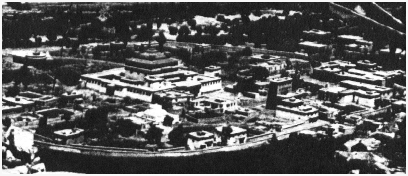Welcome to my home!

The Original Samye Ling was a huge monastic complex in Tibet ...

... today it is in South-West Scotland!

Samye was the first Buddhist monastery and study centre to be established in Tibet, some time in the late 8th century. For twelve centuries it has been one of Asia's great centres of learning.
When the present Samye Ling was founded, in 1967, it was the first Tibetan Buddhist centre in the West. Although almost a thousand others have emerged since, it still remains at the forefront, both in terms of its size and work as well as in the way it keeps pioneering the introduction of new fields of Tibetan spirituality and culture into the world at large.
Samye Ling strives to ensure the preservation of Tibetan religion, arts and medicine. Being a main point in the international network of ROKPA organisations, it also provides humanitarian aid in many countries, especially Tibet, India and Nepal. It has also become a centrepoint for an interesting programme of self-help therapy. It is living up to its name, for "Samye Ling" means unimaginable place.
I am Ken Holmes, Director of
Studies at Samye Ling, where I translate Tibetan texts and try to help
people understand Buddhism, by passing on some of the things I have learnt
during 36 amazing and incredibly fortunate years spent close to some of
the greatest spiritual teachers of the Kagyu
tradition. I have been based here since 1971.
Content
[the Kagyu is the Tibetan Buddhist lineage to which
Samye Ling belongs. The Karmapa is considered to be a living Buddha] The Karmapa: Supreme Head of the Kagyu tradition
The Karmapa: Supreme Head of the Kagyu tradition
 My work and publications:
My work and publications:
 The Kagyu Samye Ling Homepage:
The Kagyu Samye Ling Homepage:
[a site covering all Dr
Akong Tulku Rinpoche's activities in the realms of spirituality, therapy
and humanitarian aid.] The SAMYE Homepage:
The SAMYE Homepage:
[a simple introduction to Buddhism and the specific
teachings of the Karma Kagyu tradition]  Buddhism and the Kagyu tradition
Buddhism and the Kagyu tradition
 A few important points about
meditation
A few important points about
meditation
[mainly for newcomers and non-Buddhists or non-vajrayana Buddhists. This does not actually contain any meditation techniques]
Thanks for visiting my homepage. I wish you peace and happiness and hope your feet may tread the leafy paths of Samye Ling some day.
If you have any comments or suggestions, please drop me a line: kenholmes@rokpa.org
The symbol in the left margin is that of blazing jewels, on a lotus. The jewels represent the preciousness of truth, those who teach it and those who preserve it, and the lotus represents purity.
.
.